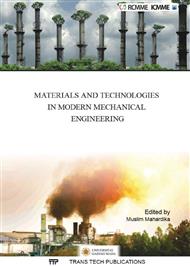p.273
p.283
p.288
p.293
p.303
p.311
p.319
p.324
p.329
Mathematical Approach for Geometric Error Modeling of Three Axis CNC Vertical Milling Machine
Abstract:
The aim of this paper overviews about to find out the errors that come from three axis CNC vertical milling machine. The errors come from, the CNC milling machine can be modelled into mathematical models and later on these error models will be used to analyse the errors in the measured data. Many errors from CNC machine tools have given significant effects toward the accuracy and repeatability of manufacturing process. There are two error sources come from CNC machine tools such as tool deflection and thermal distortions of machine tool structure. These errors later on will contribute to result in the geometrical deviations of moving axis in CNC vertical milling machine. Geometrical deviations of moving axis such as linear positioning errors, roll, pitch and yaw can be designated as volumetric errors in three axis machine tool. Geometrical deviations of moving axises happen at every axis in three axis CNC vertical milling machine. Geometrical deviations of moving axises in linear and angular movement has the amount of errors up to twenty one errors. Moreover, this geometrical errors play the major role in the total amount of errors and for that particular reason extra attention towards the geometrical deviation errors will be needed along machining process. Each of geometrical error of three axes vertical machining center is modeled using a homogeneous transformation matrix (HTM). The developed mathematical model is used to calculate geometrical errors at each axis and to predict the resultant error vector at the interface of machine tool and workpiece for error compensation.
Info:
Periodical:
Pages:
303-310
Citation:
Online since:
June 2016
Price:
Сopyright:
© 2016 Trans Tech Publications Ltd. All Rights Reserved
Share:
Citation:


